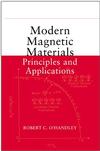Physics of Ferromagnetism
Second Edition
Soshin Chikazumi
Translation editor: C. D. Graham
Price: £165.00 (Hardback)ISBN-10: 0-19-851776-9
ISBN-13: 978-0-19-851776-4
Publication date: 27 February 1997
Clarendon Press
668 pages, halftones, numerous line figures, tables, 240x168 mm
Series: International Series of Monographs on Physics number 94
| Description |
|
- · Includes recent developments and techniques in magnetics
- · Describes magnetic phenomena intuitively and comprehensively
|
|
Readership: Graduate students and researchers in magnetism including departments of physics, materials science and materials engineering.
| Contents |
1. Magnetostatic phenomena 2. Magnetic measurements 3. Atomic magnetic moments 4. Macroscopic experimental techniques 5. Magnetic disorder 6. Ferromagnetism 7. Antiferromagnetism and ferrimagnetism 8. Magnetism of metals and alloys 9. Magnetism of ferromagnetic oxides 10. Magnetism of compounds 11. Magnetism of amorphous materials 12. Magnetocrystalline anisotrophy 13. Induced magnetic anisotropy 14. Magnetostriction 15. Observation of domain structures 16. Spin distribution and domain walls 17. Magnetic domain structure 18. Technical magnetization 19. Spin phase transition 20. Dynamic magnetization 21. Various phenomena association with magnetization 22. Engineering applications of magnetic materials |
| Authors, editors, and contributors |
Soshin Chikazumi, Professor Emeritus, University of Tokyo
Translation editor: C. D. Graham, Professor Emeritus, University of Pennsylvania
|


